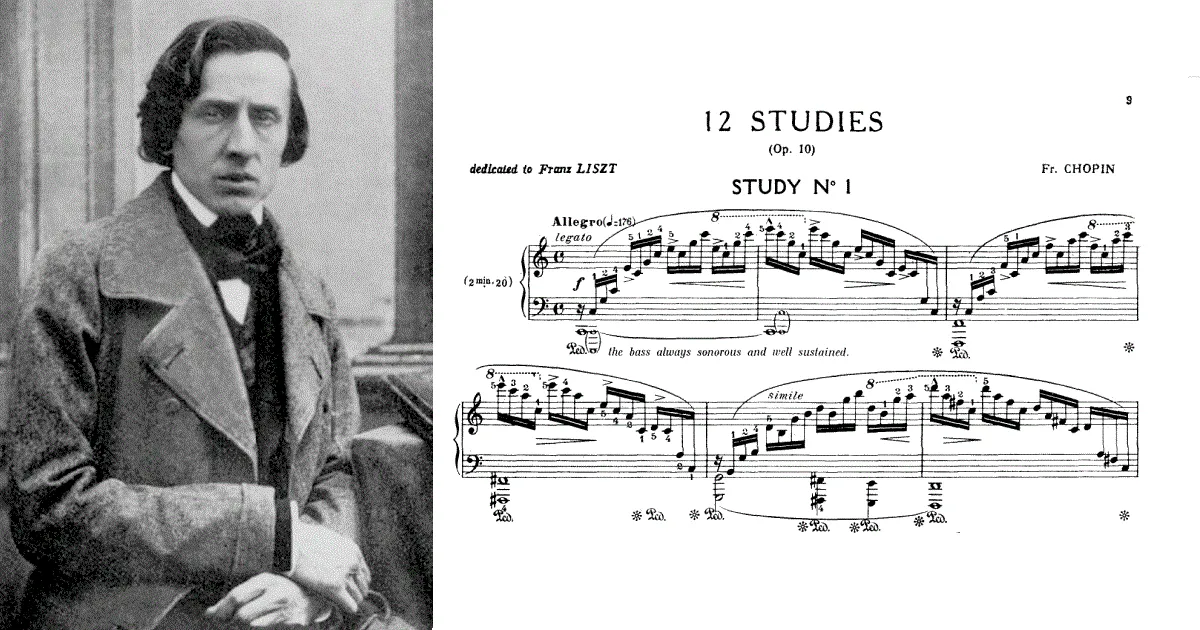When Chopin arrived in Paris from Poland in 1831, he quickly became famous as a composer and pianist. In 1833 he published his first set of études, Op. 10, which were well received. Read more about this challenging but beautiful piece!
Introduction
I decided to research and write a series of blogs on Chopin’s op. 10, no. 1 the “Waterfall” as I started to learn it. In the music I prepare, I feel an obligation to find compelling reasons why audiences should be interested in piano music and why they are worth the pianist’s time to study. In these blogs, I share some of my personal impressions of the piece and some historical connections which I find stimulating and enjoyable.
I have wanted to play this étude for a long time. When I was 10 years old, I was first acquainted with this piece by a former teacher. I remember distinctly that it was my first brush with virtuosic music, and I couldn’t quite grasp how this music was even possible to play; it far exceeded my own abilities at the time and the piece was abandoned after a few lessons. Since then, I have built my technique sufficiently and I can now enjoy this piece for the particular delight it is. Part of my appreciation for the piece also comes from placing it in its proper historical context, which I share below.
Background
When Chopin had arrived in Paris from Poland in 1831, he quickly became celebrated as a pianist and composer. In 1833, he published his first set of Études, his Opus 10, which were well received by the Parisian public. The first review, published by the French journal Le Pianiste, commented on their technical and interpretational demands.1 The anonymous reviewer stated the first étude
facilitates with intensity the extensions in the right hand and this in a completely new way … . But beware! Do not judge them at the first or even second reading. Behave as you do with Lamartine’s odes that you love so much. Look for the real meaning; discover the song, always graceful, but often enveloped in such a way as to make it difficult to find.
The acclamation of piano études as both technical and poetic studies was a first for the genre, and the adoption of them into the standard repertoire has since reshaped conceptions of what the piano as an instrument is capable of.
The op.10 études are dedicated to “son ami [the author’s friend], Franz Lizst”, who was known to sight-read the études perfectly. Liszt’s technique was, according to Chopin, optimal for playing Chopin’s own études. Chopin attests this in a letter to fellow pianist Ferdinand Hiller:2
I write to you without knowing what my pen is scribbling, because at this moment Liszt is playing my études, and transporting me outside of my respectable thoughts. I should like to steal from him the way to play my own études.
Tidbits
Below is the cover page of the original French publication of Chopin’s op. 10 from Maurice Schlesinger’s press. You might note the name of the dedicatee is misspelled as “J. Liszt” instead of “F. Liszt”. A few of Chopin’s first editions carry this error (as well as some of the re-publications), which you can find by searching through Chopin first editions on the Chopin’s First Editions Online (CFEO) website.

Considering that Franz Liszt had arrived in Paris nearly ten years before, and was at the time living and working in Paris, this typo is hard to chalk up to ignorance. I don’t think it stung Liszt very much, who likely had his name misspelled thousands of times across his European career.3
The CFEO website actually addresses this particular error, mentioning that the names and spellings of the dedicatees were not standardized across all first-edition publications. Depending on the country of publishing, some had different dedicatees altogether; Ferdinand Hiller’s name appears beside F. Liszt in the dedication of the first London edition.
Sources
Footnotes
-
Cited in Sandra Rosenblum “Chopin Among the Pianists in Paris,” In Chopin and His World, ed. by Jonathan Bellman and Halina Goldberg, (New Jersey: Princeton University Press, 2017) 271–96. ↩
-
Chopin to Ferdinand Hiller, Paris, June 20, 1833, in Chopin’s Letters, ed. E.L. Voynich, trans. Henryk Opienski (New York: Alfred A. Knopf, 1931), 170. ↩
-
Reading Alan Walker’s fantastic 3-volume biography of Liszt gives you a great impression of how public a figure he really was and how often his name was misspelled. ↩
